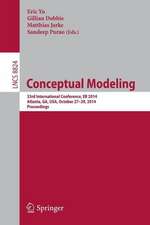Motion Planning in Dynamic Environments: Computer Science Workbench
Autor Kikuo Fujimuraen Limba Engleză Paperback – 14 dec 2011
Preț: 328.92 lei
Preț vechi: 411.16 lei
-20% Nou
Puncte Express: 493
Preț estimativ în valută:
62.95€ • 65.47$ • 51.97£
62.95€ • 65.47$ • 51.97£
Carte tipărită la comandă
Livrare economică 14-28 aprilie
Preluare comenzi: 021 569.72.76
Specificații
ISBN-13: 9784431681670
ISBN-10: 4431681671
Pagini: 196
Ilustrații: XIII, 178 p.
Dimensiuni: 170 x 244 x 10 mm
Greutate: 0.32 kg
Ediția:Softcover reprint of the original 1st ed. 1991
Editura: Springer
Colecția Springer
Seria Computer Science Workbench
Locul publicării:Tokyo, Japan
ISBN-10: 4431681671
Pagini: 196
Ilustrații: XIII, 178 p.
Dimensiuni: 170 x 244 x 10 mm
Greutate: 0.32 kg
Ediția:Softcover reprint of the original 1st ed. 1991
Editura: Springer
Colecția Springer
Seria Computer Science Workbench
Locul publicării:Tokyo, Japan
Public țintă
ResearchCuprins
1 Introduction.- 1.1 Dynamic environments.- 1.2 Statement of the problem.- 1.3 Scope of the monograph.- 2 Background.- 2.1 Stationary obstacles.- 2.2 Dynamic obstacles.- 2.3 Summary.- 3 Time-Minimal Motion: Basics.- 3.1 Introduction.- 3.2 Accessibility graphs.- 3.3 Planning and motion.- 3.4 Time-minimal motion theorem.- 3.5 Analysis.- 3.6 Discussions.- 3.7 Summary.- 4 Time-Minimal Motion: Applications.- 4.1 Concave obstacles.- 4.2 Convex obstacles.- 4.3 Start point and destination point.- 4.4 Piecewise linear motion of the obstacles.- 4.5 Nonlinear motion of the obstacles.- 4.6 Splitting and merging obstacles.- 4.7 Heuristics in dynamic domains.- 4.8 Unexpected obstacles.- 4.9 Summary.- 5 Time-Minimal Motion: Generalizations.- 5.1 Transient obstacles.- 5.2 Moving obstacles in three dimensions.- 5.3 Summary.- 6 Constrained Motion.- 6.1 Constraints on the motion of the robot.- 6.2 Space representation.- 6.3 Path search.- 6.4 Simulation results.- 6.5 Summary.- 7 Multiple Mobile Agents.- 7.1 Distributed approaches.- 7.2 Mobile agents.- 7.3 Simulation results.- 7.4 Summary.- 8 Conclusions.- 8.1 Summary.- 8.2 Open problems.- References.



















